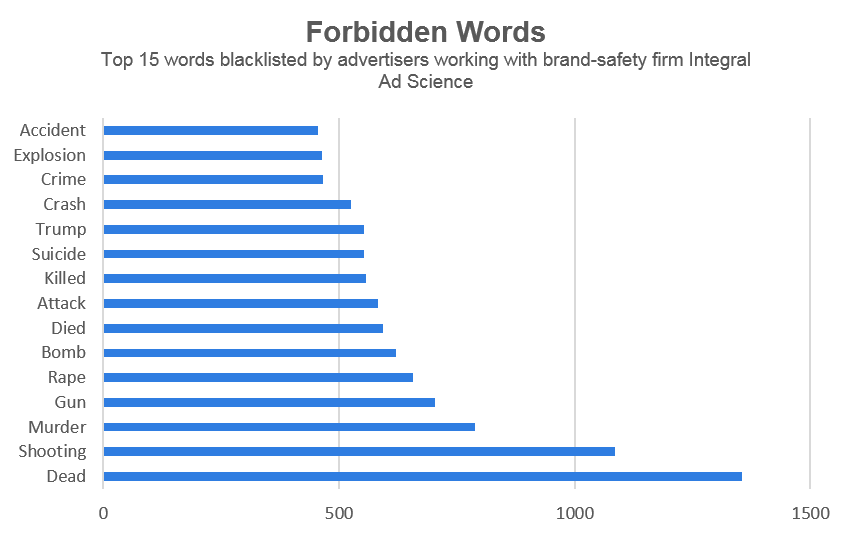
Brand safety has always been a concern for advertisers working to ensure their investment drives consumer behavior and does so in a way that doesn’t harm the brand. With the rise of digital and programmatic ad buying, brand safety risks have increased, as has advertiser awareness of ad placement. While it presents an opportunity for news media, which are known for having the most reliable brand safety, political polarization and media distrust in the U.S. has led some advertisers to hesitate when it comes to advertising in news media.
A typical example of a brand safety concern is that airlines don’t want their ads appearing next to stories about plane crashes, lest consumers connect the two. In the case of programmatic ad buying, there isn’t a human involved to spot and prevent these scenarios.
In early 2017, CPG giant Procter & Gamble cut its digital ad spending by $140 million due to concerns that its online video ads, especially on YouTube, were appearing next to brand unsafe content. Telecom giant AT&T also pulled its YouTube ads, citing the same concern. These decisions have rippled throughout the advertising and ad tech industries.
This concerning trend has opened an opportunity for news publishers, which offer advertising opportunities that encourage engagement. According to the News Media Alliance News Advertising Panorama, ads on premium editorial sites receive 50 percent more engagement than ads viewed during general internet browsing. In addition, news media have long relied on human editorial judgment to ensure brand safety issues don’t arise. News publishers are often perceived as high-quality publishers for this reason. “If we can get a quality environment, quality inventory from quality publishers, that are seen by real people in appropriate contextual environments, those ads sell better,” said Joe Barone, Managing Partner, Brand Safety Americas at the media buying company GroupM, in a 2018 interview. “Brand safety is linked directly to inventory quality and client results.”
Despite this, and despite a desire for brand safe options, some advertisers are hesitant to commit their ad budget to news media due to a different and more surprising concern – the risk of appearing next to high-quality, hard news reporting. According to an August 2019 Wall Street Journal story, some advertisers have resorted to a strategy known as language blacklisting in an attempt to avoid having their ads placed near a wide range of negative or controversial terms; some advertisers mentioned in the story seemed ready to walk away from advertising in news outlets altogether, to avoid any controversies. However, as the story explains, this “ad-blacklisting threatens to hit publications’ revenue and is creating incentives to produce more lifestyle-oriented coverage that is less controversial than hard news.”

Blacklisting is a dangerous and unnecessary strategy, as it degrades the quality and variety of news content and ignores the fact that news media already employ human editorial review to ensure ads are not placed in a brand unsafe environment.
In May, Vice Media took a stand against ad-blacklisting, detailing certain words its clients can no longer blacklist, particularly related to sexual orientation and national origin. Vice’s SVP of client partnerships for North America, Cavel Khan, wants to ensure that “bias should not be the collateral damage of our much-needed brand-safety efforts.”
Eschewing news may also have a negative impact on ads’ effectiveness. The Hard News Project, founded by UK newspaper marketing organization Newsworks, asserts that when advertisers avoid news environments, whether deliberately or as a result of their whitelisting, “content which can provide great reach, engaged audiences and contextual relevance is being shunned.”
Newsworks commissioned original research as part of the Hard News Project to understand “the benefits of advertising in the high-performing news brand environment,” partnering with Neuro-Insight to uncover consumer attitudes about the context in which they see ads. They found that the majority of consumers understand the role of news media and have positive perceptions of and trust in ads they see in both soft and hard news settings:
– 86 percent agree they “know that the role of news brands is to keep me up to date with all kinds of stories and that sometimes they can be upsetting or shocking.”
– 89 percent “like browsing my news brand and coming across new things.”
– Although some people prefer ads in a soft news context, others feel that ads in a hard news story are more trusted.
In addition, the study found that brain activity levels were higher when readers consumed hard news, suggesting readers are more engaged with the content. The data also suggest that hard news leads to a better response to ads.
Based on existing research and data around consumer engagement with advertisements in news – and some of these cutting-edge findings – we believe the value of reaching news readers continues to be high, and that avoiding news media advertising entirely will have a negative impact on brands.
Advertisers should think carefully about who they want to reach, when and how, and continue to consider news media as a high value channel to accomplish their goals. While the future ability of ad tech providers to offer brand safe environments is still unknown, print and digital news media are and will continue to be powerful, reliable and brand safe options for advertisers looking for effective media platforms in which to reach their customers.
Advertisers can feel confident when working with news media that they will receive a strong return on investment that will ensure a lasting and productive relationship.
